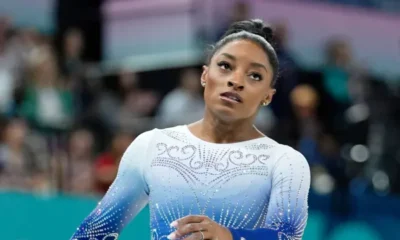CELEBRITY
Biggest revelations from Netflix’s Simone Biles Rising documentary

The decorated gymnast is the subject of a new Netflix docuseries which details her rise and comeback amidst a toxic environment for women in the sport.

Simone Biles is the most decorated gymnast in history, which is why her dramatic exit from the Tokyo Olympics four years ago sent shockwaves through the world of sport. A new four-part documentary on Netflix details the events that led to her backing out, and shines a light on toxic environment female gymnasts have weathered.
Her decision to step away came from her experience with the ‘twisties’, a condition feared by gymnasts which causes an inability to track mid-air movements and land safely. In the documentary, one former athlete makes clear continuing while suffering with the mental block could cause death.
Despite this, Biles was subjected to harsh criticism for removing herself from the competition and prioritising her mental health, the impact of which is explored in the series. The first two episodes released on the platform today (July 17) ahead of Simone’s 2024 Olympics return in Paris. Just next week, the athlete will begin her campaign in the women’s qualifiers and begin her fight to bring home another gold for Team USA.
In one moment that unfolds in episode one, Biles uncovers the outfits she was set to wear in the tournaments she withdrew from. It’s clear that even touching the fabric brings her back to an uncomfortable place as she throws the sparkling leotard back into the wardrobe.
Unsurprisingly, conversations about mental health are a running theme given how big a part this played in Biles’ Olympics exit. The athlete reveals that today prioritising mental and physical health is now “more at the forefront” of the sport than ever before; however she caveats this with the fact it’s still not a top priority.
Kerri Strug comparison
The documentary recaps on how historically attitudes towards recovery have been “warped” with athletes forced to continue competing even when injured. Kerri Strug famously injured her ankle and still competed in 1996, a comparison that was made when Biles announced her withdrawal from the Olympics.
In the documentary, the impact of the comparison on Biles is made clear. “Maybe if my ankle was fractured, yeah, I would’ve still done it,” Biles says. “But that wasn’t the case.”
She continued: “Where I was, mentally and physically, it could’ve potentially been more than an ankle or something. It could’ve been worse.”

Disgraced USA Gymnastics team doctor Larry Nassar preyed on young gymnasts in his role. He is currently serving up to 175 years in prison for sexual assault convictions and others relating to images of child sex abuse.
Biles has previously testified about the abuse she suffered at Nassar’s hands and in the documentary, says she believes her struggles with the twisties was actually a trauma response. “Everything that has happened I’ve just like, ‘I’ll push it down, shove it down, wait until my career’s done, go fix it,” she says. “Then something like this happens, and unfortunately, to me, it happened at the Olympics. It’s a trauma response.”
“Your mind and your body is the first one to say, ‘actually, no’. You just never know how you’ll react when you start actually talking about that and trying to start the healing process… you can only shove stuff down for so long.”
The athlete recounts negative comments she has received about her appearance over the course of her career, including one remark that her hair looked ‘crunchy’. “People are way too comfortable commenting things…. I think the beauty standard, everything, is just too much,” Biles says.
One former athlete highlights how typically the idea of beauty in the sport has been ‘blond, straight hair’, as Biles recounts knowing what it’s like being “the only Black girl on the team”, with few other Black Olympic gymnasts to look up to
Biles has a tattoo on her collarbone that reads ‘And still I rise’ in a cursive font. The phrase is the title of a poem by Maya Angelou which the athlete says she felt drawn to.
“Before I got this tattoo, it was a saying that I loved — obviously, Maya Angelou — and I was like, ‘And still I rise is perfect’ because I feel like that’s kind of the epitome of my career and my life story,'” she explained. “Because I always rise to the occasion and after all of the traumas and downfalls, I’ve always risen.”






















